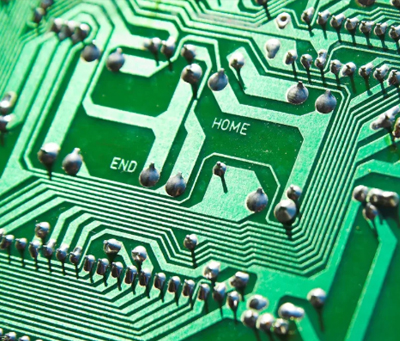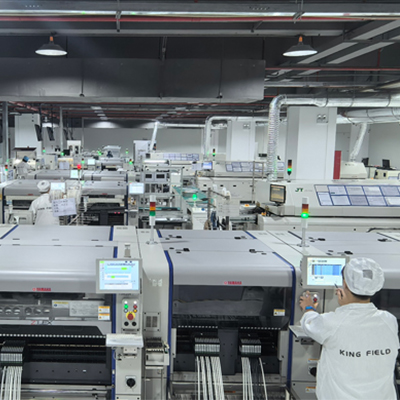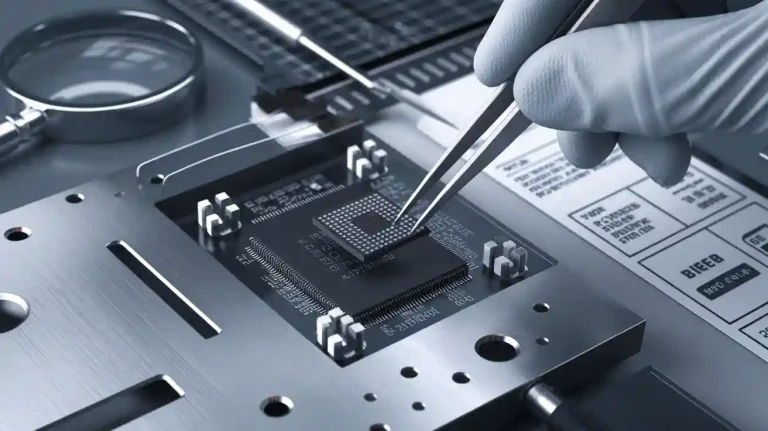The Future of Industrial Control PCBA Design and Manufacturing
Industrial control systems use PCBAs to run their operations. PCBAs are like the heart of automation, helping systems work well. New designs have changed how these assemblies work. Engineers now make smaller circuits with detailed layouts to work better. New tools let you test and improve circuits before making them. These changes help industries by creating smarter and faster systems. As you learn about these updates, it’s clear that industrial control needs creative PCBA designs for the future.
Key Takeaways
- PCBA is key for industrial systems. It supports automation and keeps things running smoothly.
- Use AI and machine learning to improve PCBA design. These tools make production faster and reduce mistakes.
- Work on making smaller and more packed designs. This helps meet the need for tiny and powerful devices.
- Use green methods in PCBA making, like recycling and eco-friendly solder. This helps the planet and saves money.
- Be careful with cybersecurity for IoT PCBs. Add strong protections early to stop possible dangers.
Current State of Industrial Control PCBA
Current PCBA Technologies and Their Applications
Industrial control systems use advanced PCBAs for modern needs. Surface Mount Technology (SMT) makes circuits smaller and more reliable. Ball Grid Array (BGA) helps circuits work better in tight spaces. Hybrid PCBs mix stiff and bendy parts for special designs. AI tools make PCB production faster and more efficient in factories.
| Technology | Description | Applications |
|---|---|---|
| SMT | Makes circuits smaller and more reliable. | Used in many electronic devices. |
| BGA | Improves circuit performance in small spaces. | Found in high-density electronics. |
| Hybrid PCB | Mixes stiff and bendy parts for special designs. | Used in advanced, multi-use electronics. |
| AI in PCB Manufacturing | Speeds up production and improves efficiency. | Used in modern PCB factories. |
Manufacturing Processes in Industrial Control PCB Assembly
Making PCBAs needs careful steps to ensure quality. Soldering connects parts to the circuit boards. Machines check for mistakes using cameras and x-rays. X-rays find hidden problems like bad solder joints. Quality tests make sure the final product works well. These steps help meet standards and reduce errors.
Challenges in Existing PCBA Design and Production
Designing and making PCBAs has some tough problems. Fast circuit layouts need teamwork between engineers and designers. Power and signal issues must be fixed early to save time. Planning helps make production easier and faster. Power checks stop power drops and keep things stable. Fast switching can cause noise, so capacitors are used. Noise from switching can also cause timing errors, needing special tools.
These problems show why new ideas are needed to improve PCBA design and production.
Emerging Trends in PCBA Design and Manufacturing
AI and Machine Learning in PCBA Development
AI and ML are changing how we design PCBs. These tools study data to improve layouts and find problems early. AI can handle boring tasks like placing parts and drawing paths. This saves time and lowers mistakes when designing. ML learns from old designs to suggest better ideas, making PCBs work smarter.
You can test your PCB with AI simulations before building it. These tests find weak spots and check if it works well. During production, AI helps spot defects faster than older methods. This makes products more reliable and cuts down on waste.
Tip: Try using AI design tools to work faster and smarter.
IoT Integration in Industrial Control PCBs
The IoT is changing how industrial systems work. IoT-ready PCBs let devices share data easily. You can add sensors to check things like heat and pressure. These sensors send live updates to help you make better choices.
IoT also makes systems run better. Smart PCBs can warn you about problems before they stop work. For example, a motor PCB can tell you when it needs fixing. This saves money and keeps machines running longer.
Keeping data safe is very important for IoT PCBs. You need to design them with security features like encryption. As more people use IoT, secure PCBs will be even more needed.
Miniaturization and High-Density PCB Assemblies
Making PCBs smaller is a big trend now. Tiny devices need compact PCBs with lots of parts packed in. You can use special methods like microvias to fit more into less space.
High-density PCBs make systems faster and more efficient. Multi-layer PCBs can handle tricky circuits better. These layers cut down on interference and keep signals clear.
Building high-density PCBs needs careful work. Machines place tiny parts exactly where they belong. Strong materials are used to make sure they last in tough conditions. Smaller PCBs open doors for new uses, like robots and medical tools.
Note: Focus on smaller designs to meet the need for compact, powerful systems.
Advanced Materials and Sustainable PCBA Practices
The materials used in PCBA design are very important. They affect how well and how long the PCBA works. New materials are changing how PCBAs perform in industrial systems. At the same time, eco-friendly methods are helping the planet. Let’s see how these ideas are shaping the future.
Advanced Materials in PCBA Design
New materials make PCBAs stronger, lighter, and better. They help with heat, electricity, and reliability. Here are some examples:
- High-Temperature Laminates: These can handle very high heat. They stop bending and stay stable in tough places.
- Ceramic Substrates: Ceramics manage heat well and block electricity. They work great in high-power systems where heat is a problem.
- Flexible Polymers: These bendy materials let you make flexible PCBAs. They are good for small gadgets or moving parts.
- Conductive Inks: These inks let you print circuits on surfaces. This saves materials and allows new designs.
Tip: Pick materials that match your system’s needs. Heat, water, and stress can affect how materials work.
Sustainable Practices in PCBA Manufacturing
Being eco-friendly is now a must. You can use green methods to cut waste and save energy. Here’s how:
- Recycling and Reusing Materials: Factories recycle copper, solder, and more. This saves resources and lowers costs.
- Using Lead-Free Solder: Old solder has lead, which harms the earth. Safer options like tin-silver-copper work just as well.
- Energy-Efficient Manufacturing: New machines use less power but still work well. Switching to these machines helps the environment.
- Reducing Chemical Waste: Use water-based cleaners instead of harsh chemicals. This is safer for workers and nature.
The Benefits of Combining Advanced Materials and Sustainability
Using new materials with green methods gives great results. For example:
- Improved Durability: Better materials last longer, so you replace them less often.
- Lower Costs: Recycling and saving energy cut expenses over time.
- Eco-Friendly Reputation: Green practices make your brand look good and follow rules.
Note: Being eco-friendly isn’t just good for the earth. It also makes your work cheaper and more efficient.
By using these ideas, you can make better PCBAs. These changes help both your products and the planet. Together, they create a smarter and greener future for industrial systems.
Challenges in Future PCBA Manufacturing
Supply Chain and Material Availability Issues
Supply chain problems are a big challenge for PCBA making. Shortages of materials like copper and solder slow production. Delays also raise costs and make meeting deadlines harder. Reliable suppliers are needed to keep materials available.
Using discrete event simulation (DES) can help solve these issues. DES models show how shortages and delays affect production. It helps predict problems and improve planning. With DES, you can reduce risks and keep schedules on track.
To fix supply chain issues, use more than one supplier. Stock up on important materials to avoid running out. Talk often with suppliers to know about possible delays.
Increasing Complexity in PCB Circuit Designs
Modern PCBs are getting harder to design. Devices need smaller, faster, and better circuits. High-density parts and multi-layer boards improve performance but are tricky to make.
Complex circuits need careful placement of parts. Bad layouts can cause power or signal problems. Advanced software tools help design circuits correctly. Simulations test designs to find weak spots before production.
Checking for mistakes is very important for complex PCBs. Automated optical inspection (AOI) systems use cameras to find errors fast. Catching problems early keeps quality high and avoids costly fixes.
Skilled Labor Shortages in PCBA Production
Finding skilled workers for PCBA production is tough. New technology needs trained people to run machines and check PCBs. Training workers takes time and money.
Automation can help by doing repetitive tasks like soldering. Machines speed up work and need fewer workers. But skilled people are still needed to manage and fix machines.
Training programs are key to solving this problem. Partner with schools to teach PCB design and manufacturing. These programs prepare workers for modern factory jobs. A trained workforce ensures your factory runs well in the future.
Cybersecurity Issues in IoT-Connected PCBs
IoT-connected PCBs have changed how industrial systems work. They link devices and share data instantly. But these changes bring big cybersecurity risks. More connected devices mean more chances for cyberattacks. Hackers may target IoT systems to cause problems or steal data.
Cybersecurity threats are growing fast. In 2019, only 24 new vulnerabilities (CVEs) were found in the automotive field. About 20-22% of these were serious. By 2024, new CVEs jumped to 422, with a total of 1,147. Shockingly, 60% of these were high-risk. This shows how risky IoT-connected PCBs can be in industries.
| Year | New CVEs | Total CVEs | High-Risk Cases (%) |
|---|---|---|---|
| 2019 | 24 | 24 | 20-22% |
| 2020 | N/A | N/A | 20-22% |
| 2021 | N/A | N/A | 20-22% |
| 2022 | N/A | N/A | 20-22% |
| 2023 | N/A | N/A | ~50% |
| 2024 | 422 | 1,147 | 60% |
To keep IoT PCBs safe, focus on security from the start. Use encryption to protect data during transfers. Add authentication to check device identities before they connect. These steps block unauthorized access and lower attack risks.
Regular system checks are also important. Watch for strange activity to catch threats early. Automated tools can find weak spots and suggest fixes. Updating software and firmware makes your system even stronger.
As IoT use grows, so will cybersecurity challenges. Strong security steps can protect your IoT PCBs and keep your systems working well.
Benefits of Future PCBA Innovations
Better Efficiency in Industrial Control Systems
Future PCBA designs will make systems work much better. New microcontrollers and digital signal processors (DSPs) will give precise control. These parts use smart methods like FOC and SVPWM to improve motors. Clever control systems also help motors run smoothly and save energy. High-efficiency power parts will use less energy in motor systems.
These updates make systems faster and smoother. With better energy use, you can save money and get more done.
Stronger PCBs for Tough Workplaces
Factories and plants can be hard on PCBs. Future designs will handle heat, stress, and tough conditions better. Special materials like high-temperature laminates and ceramics will protect PCBs. Flexible materials will let PCBs bend and handle vibrations without breaking.
Better ways to make PCBs will also help them last longer. Careful checks, like AOI, will make sure every PCBA is top quality. These steps will keep systems working well, even in rough places.
Easy to Grow for Bigger Needs
As industries grow, systems need to grow too. Future PCBA designs will make it easy to add or upgrade parts. Modular designs let you expand without replacing everything. High-density PCBs will fit more features into smaller spaces.
These scalable PCBs are great for factories, energy, and healthcare. They adjust to new needs, keeping your systems useful and up-to-date. By choosing scalable PCBA designs, you can stay ready for the future and ahead of others.
Cost-Effectiveness Through Advanced Manufacturing Techniques
Advanced manufacturing methods help save money and improve PCBA quality. These techniques reduce waste, speed up production, and use resources wisely. By using them, you can cut costs and stay ahead in the industry.
Key Techniques That Boost Cost-Effectiveness
- Automation in Assembly
Machines do tasks like soldering and checking parts. They work faster and make fewer mistakes than people. This lowers labor costs and keeps quality steady. Adding automation can make your production smoother. - Lean Manufacturing
Lean methods remove extra steps in making products. They use fewer materials and recycle leftovers like copper. This saves money and helps the planet. Reusing parts also cuts waste and costs. - High-Speed PCB Prototyping
Quick prototyping tools test designs fast. They find problems early, avoiding costly fixes later. These tools save time and money by making sure designs are ready to build.
Benefits of Advanced Techniques
| Technique | Cost-Saving Benefits |
|---|---|
| Automation | Lowers labor costs and boosts efficiency. |
| Lean Manufacturing | Reduces waste and material costs. |
| High-Speed Prototyping | Stops expensive design mistakes. |
Tip: Start small by automating one task. Add more as you see success.
Why These Techniques Matter
Using advanced methods lets you make better PCBAs for less money. You can use the savings to grow your business or create new ideas. These methods also make your work eco-friendly, which customers and regulators like.
By following these strategies, you can build a smarter and cheaper production process. This keeps your products strong in a fast-changing market.
Industry Uses of Advanced PCBA
Manufacturing and Automation Systems
Modern factories use advanced PCBs to run machines. They help programmable logic controllers (PLCs) and servo systems work. These systems control robots and make them move smoothly. Robots with PCBs work faster and better, saving time and effort. For example, special PCBs check products for mistakes during production. This keeps quality high and reduces waste.
PCBs are also used in electronics and cars. They make devices work better and last longer. In robots, PCBs help them move accurately and make quick decisions. This is important for assembly lines. Advanced PCBs have changed how factories work, making them faster and more reliable.
| Use Area | What It Does |
|---|---|
| Factory Control | PCBs help PLCs and servo systems run machines automatically. |
| Robots | PCBs make robots work efficiently and improve automation. |
| Quality Checks | PCBs process images to find mistakes during production. |
Energy and Power Management Systems
Advanced PCBs are key in energy systems. They control how power is shared and stored. Solar panels and wind turbines use these PCBs to work better. They check voltage and current to stop power problems and keep systems steady.
Smart grids also use PCBs to connect devices. They help save energy and reduce waste by sharing data in real time. Using advanced PCBs makes energy systems more efficient and reliable.
Transportation and Delivery Technologies
Vehicles need advanced PCBs to work safely and smoothly. PCBs control brakes, navigation, and engines. They make driving safer and easier. For delivery, PCBs power trackers and sensors to show where shipments are.
Self-driving cars use PCBs to read data from cameras and sensors. This helps them plan routes and deliver faster. Advanced PCBs improve transportation and delivery, making them quicker and more dependable.
Healthcare and Medical Device Innovations
Healthcare devices depend on advanced PCBs to work well. These devices, like diagnostic tools and life-saving machines, need to be precise and reliable. Modern PCBs are made to meet these needs, ensuring they perform accurately in important tasks.
Medical tools such as heart monitors, insulin pumps, and imaging machines use PCBs to process data and control functions. These PCBs handle tough jobs like tracking vital signs or giving medicine exactly when needed. Their small size and efficiency make them perfect for portable and wearable devices, which are becoming more common.
Checking PCBs is very important to keep medical devices safe. Factories use special methods like automated optical inspection (AOI) to find problems during production. This ensures every PCB meets strict medical rules and lowers the chance of device failure. Early checks help keep medical tools reliable.
The materials in medical PCBs also make them strong and safe. For example, biocompatible materials stop bad reactions when touching the body. Heat-resistant materials let PCBs handle cleaning processes, which are key for keeping devices germ-free.
As technology grows, PCBs will be used in even smarter ways. For example, smart implants with PCBs can track health and send updates to doctors. These new ideas improve patient care and create chances for personalized treatments.
By learning about PCBs in healthcare, you can see how they make medical devices better and more dependable. Their role in healthcare keeps growing, shaping the future of medical technology.
PCBA improvements are changing how industrial control systems work. They make systems faster, stronger, and easier to expand. To use them fully, fix problems like material shortages and cyber threats. Checking often and using new methods can solve these issues. By using these technologies, you can create smarter and more dependable systems. The future of industrial control depends on your creativity and flexibility.
FAQ
What is PCBA, and why is it important in industrial control systems?
PCBA means Printed Circuit Board Assembly. It holds and connects electronic parts in machines. PCBA helps machines work well, process data correctly, and stay reliable. Without PCBA, advanced machines and automation wouldn’t work properly.
How does AI improve PCBA design and manufacturing?
AI handles boring tasks like placing parts and drawing paths. It studies data to improve designs and find mistakes early. You can also test PCBs with AI before making them. This lowers errors, saves time, and makes better assemblies.
Why is sustainability important in PCBA manufacturing?
Sustainability helps the planet and saves resources. Recycling materials, using safer solder, and saving energy are key steps. These actions cut costs and make your products better for eco-friendly buyers.
What challenges do IoT-enabled PCBs face?
IoT PCBs face risks like hacking and stolen data. Adding encryption and passwords can protect important information. Regular updates and checks also stop unwanted access, keeping systems safe and working well.
How can you address skilled labor shortages in PCBA production?
Use machines to do simple, repeated jobs and need fewer workers. Work with schools to train people for PCBA jobs. These steps help prepare workers for today’s factory needs.




















